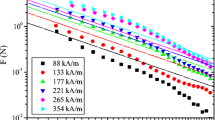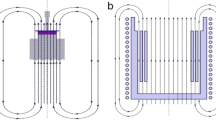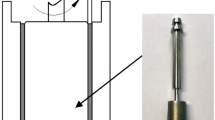Abstract
A micro–macro description for the constitutive behavior of magnetorheological fluids (MRFs) under shear deformation is formulated based on a more exact magnetic-dipolar model and a statistical approach. The conventional Bingham’s model of viscoplasticity and the dual-viscosity model for MRFs can be obtained from the proposed model as the special cases. This model can take into account the effect of each of the main influencing factors, such as the intensity of magnetic induction, the size, and the volume fraction of particles, shear strain and shear strain rate, saturated magnetization, on the yield shear stress of MRFs. The satisfactory agreement with the experimental results demonstrates the validity of the proposed model. The effect of light weight coating on the sedimentation velocity of the suspended particles is also investigated. This model can evaluate comprehensively the overall property of an MRF and the effects of different main influencing factors; therefore, it may also be of help for the initial design and optimization of high-performance MRFs.










Similar content being viewed by others
References
Bonnecaze RT, Brady JF (1992) Dynamics simulation of an electrorheological fluid. J Chem Phys 96:2183–2202
Bossis G, Lemaire E (1991) Yield stresses in magnetic suspensions. J Rheol 35:1345–1354
Chang J, Yang YM, Peng X (2001) Research on a magnetorheological fluid rheological property testing device. Chin J Sci Instrum 22:354–358
Fang S, Zhang P (2001) Simulation of the structure and the dynamics of the particles of MR fluids in rotating magnetic fields. Chin J Chem Phys 14:562–566
Furst E, Gast A (2000a) Dynamics and lateral interactions of dipolar chains. Phys Rev E 62:6916–6925
Furst E, Gast A (2000b) Micromechanics of magnetorheological suspensions. Phys Rev E 61:6732–6739
Ginder J, Davis L (1994) Shears tress in magnetoreological fluids: role of magnetic saturation. Appl Phys Lett 65:3410–3412
Gong RZ, Guan JG, Yuan RZ (2000) Properties of magnetorheological suspension for filled clusters of Cobalt Phthalocyanine/Iron nanoparticles. Chin Chem Phys 13:508–512
Guan JG, Wang W, Gong RZ, Yuan RZ, Gan LH, Tam KC (2002) One-step synthesis of cobalt-phthalocyanine/iron nanocomposite particles with high magnetic susceptibility. Langmuir 18:4198–4204
Jolly MR, Carlson JD, Munoz BC (1996) A model of the behavior of magnetorheological materials. Smart Mater Struct 5:607–614
Karakoc K, Park EJ, Suleman A (2008) Design considerations for an automotive magnetorheological brake. Mechatronics 18:434–447
Kavlicoglu B, Gordaninejad F, Evrensel C, Fuchs A, Korol G (2006) A semi-active, high-torque, magnetorheological fluid limited slip differential clutch. J Vib Acoust 128:604–610
Lemaire E, Meunier A, Bossis G, Liu J, Felt D, Bashtovoi P, Matoussevitch N (1995) Influence of the particle size on the rheology of magnetorheological fluids. J Rheol 39:1011–1020
Li WH, Du H (2003) Design and experimental evaluation of a magnetorheological brake. Int J Adv Manuf Technol 21:508–515
Milecki A, Sedziak D, Ortmann J, Hauke M (2005) Controllability of MR shock absorber for vehicles. Int J Veh Des 38:222–233
Peng X, Li H (2007) Analysis of the magnetomechanical behavior of MRFs based on micromechanics incorporating a statistical approach. Smart Mater Struct 16:2477–2485
Shkel YM, Klingenberg DJ (2001) Magnetorheology and magnetostriction of isolated chains of nonlinear magnetizable spheres. J Rheol 45:351–368
Spasojevic D, Irvine TF, Afgan N (1974) The effect of a magnetic field on the rheodynamic behaviour of ferromagnetic suspensions. Int J Multiph Flow 1:607–622
Tang XL, Conrad H (1996) Quasistatic measurements on a magnetorheological fluid. J Rheol 40:1167–1178
Wan F, Ma X (1994) Magnetic physics. Electric Industry Press, Beijing
Xing Z, Lv JG, Li M (2005) Behavior analysis and experimental research on magnetorheological fluids. J Magn Mater Devices 36:21–23
Yan WG, Liu SY, Li JJ, Xu YQ (2000) Passive magnetorheological fluid filled hydraulic engine mount. J Beijing Inst Technol 9:434-438
Yang G, Spencer BF, Carlson JD, Sain MK (2002) Large-scale MR fluid dampers: modeling and dynamic performance considerations. Eng Struct 24:309-323
Acknowledgements
The authors gratefully acknowledge the financial support to this work from the Natural Science Foundation of China under Grant No. 10872220.
Author information
Authors and Affiliations
Corresponding author
Appendix
Appendix
The intensity of magnetic field at point P (Fig. 1) caused by a magnetic pole Q m can be expressed as
Thus, the contribution of a dipole with two magnetic poles \(Q_m^+\) and \(Q_m^-\) (Fig. 1) can be expressed as
Substituting Eq. 35 into 34 gives
Making use of the following definitions
where j is the magnetic dipolar moment of a magnetized dipole, Eq. 36 can be rewritten as
In free space
It should be noted that, in the existing work, it is usually assumed that || r 1 || ≫ a and || r 2 || ≫ a. Making use the condition \(\frac{a}{\| {{\rm {\bf r}}_1 } \|}\approx 0\) and \(\frac{a}{\| {{\rm {\bf r}}_2} \|}\approx 0\), Eq. 39 are reduced to (Fang and Zhang 2001)
Ignoring the additional magnetization of a particle caused by the other magnetized particles, considering a constant applied magnetic field, and making use of the relationship (Fang and Zhang 2001)
the magnetic force on the ith particle, F i , can be derived as
where a i = a j = 2R, \({\rm {\bf m}}_i\, \approx\, {\rm {\bf m}}_j \,\approx\, {\rm {\bf m}}\,=\,\frac{4}{3}\pi R^3\chi {\rm {\bf H}}\,\approx\) \(\frac{4}{3}\pi R^3\chi {\rm {\bf H}}_0 \) and m i ≈ m j ≈ m have been employed, ignoring the disturbance of magnetic dipoles \({\tilde {\bf {H}}}\) to the magnetic field since \({\tilde {\bf {H}}}\) ≪ H 0 , and \(r_1 =\sqrt {r_{ij}^2 + R^2 - 2Rr_{ij} \cos \theta}\) and \(r_2 =\sqrt {r_{ij}^2 +R^2+2Rr_{ij} \cos \theta}\).
Rights and permissions
About this article
Cite this article
Yi, C., Peng, X. & Zhao, C. A magnetic-dipoles-based micro–macro constitutive model for MRFs subjected to shear deformation. Rheol Acta 49, 815–825 (2010). https://doi.org/10.1007/s00397-010-0468-3
Received:
Revised:
Accepted:
Published:
Issue Date:
DOI: https://doi.org/10.1007/s00397-010-0468-3




